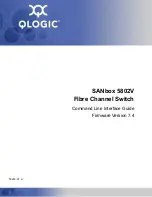
1
SLX SERIES
SCI-162 PROTOCOL INSTRUCTIONS
INTRODUCTION
The SCI-162 control interface card is the heart of
the Sigma Series SLX source selection switchers. The
SCI functions as the controller between the user and
the switch crosspoints. The SCI will make a switch
during the vertical interval, and this switch can be
generated one of two ways: by the control panel or by
the serial port.
The SCI can support either RS-232 or RS-422
communications. Unless specified otherwise at time of
order, the switcher will be set for RS-232
communications. Changing from RS-232 to RS-422
will require removal of the SCI-162 module from the
frame. The communication cable will need to be
moved from the RS-232 connector to the RS-422
connector.
Communications through the serial port is achieved
with a straightforward ASCII instruction set. Upon
receipt of a command, The SCI will interpret and
execute the instruction unless responses are
suppressed, the SCI will issue a response of “OK” to
the sending device upon completion of each
transaction. If the SCI receives an invalid command a
response of “?” will be transmitted.
SCI 162 - RS232 PROTOCOL
Commands are issued from a computer/terminal
keyboard using standard ASCII letters and numbers.
The SCI is not case sensitive, and therefore does not
care whether you use capital letters or lower case
letters.
The ASCII protocol for making an audio-follow-
video switch is:
IxxOxx
{RETURN/ENTER}
The 'I' represents INPUT and the 'O' OUTPUT. The
'xx' represents the one or two digit number of the
respective INPUT and OUTPUT. The leading zero is
optional. Valid INPUT numbers for the SCI are 01-32.
Valid OUTPUT numbers are 01-02. To generate the
TAKE, press the RETURN/ENTER key on the
keyboard. When the SCI receives the request and
executes the change, it will respond with an ASCII
message 'OK' (unless disabled - see "N/Y" command
explanation).
The ASCII protocol for making a BREAKAWAY is:
AxxOxx
{RETURN/ENTER}
The 'A' could actually be A or B. These two letters
represent the two input levels respectively. An "A"
corresponds to Level 1 (video) and a "B" represents
Level 2 (audio). Again, the 'O' is the OUTPUT. In this
case, only the requested input Level will change.
The ASCII protocol for making a SPLIT is:
AxxBxxOxx
OR
BxxAxxOxx
In this example, the inputs for both levels are
assigned different numbers, but both will go to the
same OUTPUT. Again, it is not necessary to supply
the leading zero in assigning numbers. A07B03O01 or
A8B5O2 will both work.
The STATUS of either OUTPUT can be obtained by
entering the following:
Sxx
{RETURN/ENTER}
The 'S' represents STATUS and the 'xx' represents
the one or two digit ASCII number of the OUTPUT. As
before, the leading zero is optional. Press the
RETURN/ENTER key to generate execution. The SCI
will respond with the following ASCII message:
OUTPUT xx LEVEL 1 xx LEVEL 2 xx
In a STATUS request, the SCI will generate a
leading zero for all numbers that require one.
A GLOBAL STATUS can also be generated. This
will give the STATUS for all the active OUTPUTS (up
to 2). By default, those OUTPUTS not yet addressed
will be indicated as having INPUT 01 selected. The
protocol sequence for a GLOBAL STATUS is:
SA
{RETURN/ENTER}
The 'S' represents STATUS and the 'A' represents
all. As always, press the RETURN/ENTER key to
execute the command. The SCI will respond with the
following:
L1 L2 OUT
xx xx xx
xx xx xx
Anytime an invalid or incomplete message is sent to
the SCI, it will respond with an ASCII '?' (unless
disabled, see "N/Y" command). This will occur for each
group of invalid characters it receives. The RETURN /
ENTER key is the delimiter between commands.
Therefore, invalid characters will not cause a '?'
response until the RETURN/ENTER key has been
sent.































